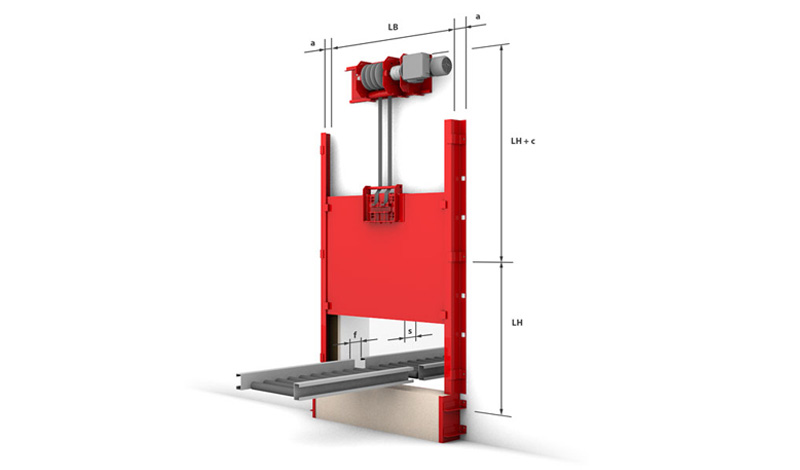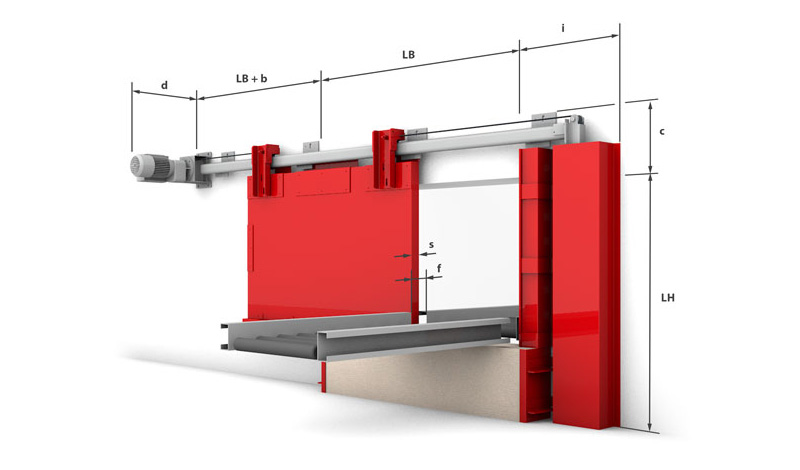SYSTÈME: GCC
| Type de construction | Fermeture coupe-feu au cours des installations de convoyage liées à la voie |
| Certificat de conformité | ETA-16/0851 Evaluation technique européenne | VKF Renseignements techniques Nr. 32235 |
| Direction de la fermeture | de haut en bas | de gauche à droite | de droite à gauche |
| Résistance au feu | EI1 90 | testé selon DIN EN 1366-7:2004 | classé selon EN 13501-2:2007 | Cycles de fermeture | C4 | nombre de cycles de fermeture 100.000 | sens de fermeture vertical C5 | nombre de cycles de fermeture 200.000 | sens de fermeture horizontal |
| Réouverture | motorisé |
| Système de convoyage | Transporteur discontinu | Transporteur à pente descendante | Transporteur à bande continue | Transporteur continu Chariot de déplacement | Technique de convoyage à chaîne porteuse continue | Technique de convoyage à rouleaux continue | Technique de convoyage en continu |
| Surfaces visibles | Pièces rapportées: galvanisé | revêtu dans la teinte RAL | acier inoxydable 1.4301 (V2A) Panneau fixe et pelle de la vanne : panneaux coupe-feu non traités | peints avec une peinture à dispersion dans une teinte proche de RAL | revêtement en tôle galvanisée | revêtement en tôle en acier inoxydable 1.4301 (V2A) | revêtement en tôle revêtu dans une teinte RAL |
Dimensions et structure du système
La combinaison de classifications ou le rapport entre la largeur intérieure du système et la hauteur intérieure du système peuvent réduire les dimensions maximales mentionnées et les dimensions du caisson et des rails de guidage peuvent varier. Les indications figurant sur l'offre font foi.
| Elément de construction (structure porteuse) dans lequel la fermeture peut être installée | Classe de résistance au feu pouvant être atteinte | |||
| Largeur maximale LB | la plus grande hauteur LH | plus grande surface | ||
| Mur massif de haute densité, maçonnerie ou béton massif avec densité totale ≥ 800 kg/m3 et une épaisseur ≥ 150 mm | EI1 90 EI2 90 | 3.600 mm | 4.200 mm | 10,0 m2 |
| Mur massif basse densité, béton cellulaire de densité globale de ≥ 450 kg/m3 et d'une épaisseur ≥ 150 mm | EI1 90 EI2 90 | 3.600 mm | 4.200 mm | 10,0 m2 |
La situation de montage doit être conforme aux exigences légales de construction du pays de montage. La résistance au feu d'une structure porteuse de plafond ou de mur et des éléments de construction adjacents doit correspondre au moins à celle de la fermeture coupe-feu et/ou pare-fumée/rideau coupe-feu et/ou pare-fumée. La preuve de la stabilité et de l'aptitude au service des parois et éléments de construction adjacents doit être apportée dans les conditions ambiantes générales et en cas d'incendie. Voir également les indications relatives à la structure porteuse normalisée dans la norme EN1366-7:2004 ou EN1363-1:2020. Le système de protection incendie ne doit pas non plus être soumis à une charge supplémentaire en cas d'incendie, hormis son propre poids.


